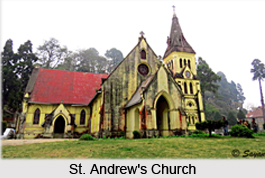 Monuments in Darjeeling present a historical account of the hill station and also offer a suitable opportunity for tourists to visit these places of interest. Darjeeling hill town in West Bengal has derived its name from the monastery Dorje Ling, which means, `a place of Thunderbolt.` The British rulers chose this hill station of the Himalayas to construct a sanatorium in the 19th century. It gradually became the summer capital of Bengal because of its salubrious climate. Even to this day, much of the splendours of the British Raj can be seen in Darjeeling with their Nepali, Tibetan and Bengali characters. This bewitching view of the hill station crouches precariously on the hillside, and possesses three main thoroughfares, Hill Cart Road, The Mall and Laden Road.
Monuments in Darjeeling present a historical account of the hill station and also offer a suitable opportunity for tourists to visit these places of interest. Darjeeling hill town in West Bengal has derived its name from the monastery Dorje Ling, which means, `a place of Thunderbolt.` The British rulers chose this hill station of the Himalayas to construct a sanatorium in the 19th century. It gradually became the summer capital of Bengal because of its salubrious climate. Even to this day, much of the splendours of the British Raj can be seen in Darjeeling with their Nepali, Tibetan and Bengali characters. This bewitching view of the hill station crouches precariously on the hillside, and possesses three main thoroughfares, Hill Cart Road, The Mall and Laden Road.
As per legend, the hill station of Darjeeling was hit by a mystic thunderbolt of the Lamaist religion, which is regarded as the wand of Indra, who is the Lord of all Gods. It apparently fell on a place called as the Observatory Hill. In Sanskrit language, the word `Durjay Ling` is referred to as `Shiva of invincible prowess, who rules the Himalayas`. Till the earlier parts of the eighteenth century, Darjeeling was under the rule of the Rajas of Sikkim, who lost it to the invading Gurkha tribes from Nepal in the year 1780. In the year 1828, two British officers named Mr. J.W Grant and Captain G.W.A.Lloyd stumbled upon this distant Shangri-La and understood its importance as a strategic link with Tibet and Nepal, and a hill station sanatorium. By the order of the then Governor General, Captain Lloyd negotiate with the Sikkim Raja on the month of February 1835, the hill station of Darjeeling was offered to the British East India Company. Thus, it was made a famous resort for those Britons who looked for some respite from the sweltering heat in the plains.
Counted as one of the major hilly regions of India, Darjeeling is a famous hill stations which is renowned for the sublime grandeur of its scenery and the stunning views of the snow-clad eastern Himalayas. The centre or Chowrasta (literally four roads) is a large, open space marked by an ornamental bandstand, the Charing Cross of Darjeeling. Leading from north-east to the north-west is the Mall, the main promenade of the station, which encircles Observatory Hill, a bracing and rewarding walk. From the top of the hill twelve peaks can be seen, all over 6,100 meters, including Kanchenjunga Peak, 72 kilometres away. Beneath are picturesque, wooded foothills. St Andrew`s Church is located on a knoll to the left of Observatory Hill, close to the Gymkhana Club. The original church was designed by Captain Bishop in the year 1843, but this collapsed in the year 1867. It was again reconstructed in the year 1873. Later, a large clock tower, porches and the north and south transepts were added. Inside the church, there are numerous interesting memorial tablets.
St Columba`s Kirk situated close to the Railway Station, has good stained glass to the family of Peterson Lennox Black-wood. There is a Union Chapel. The Roman Catholic Church below the Mall is a part of the Loretto convent. At a distance of about 800 meters beyond St Andrew`s is Government House. On a fine site with grounds resembling an English park, the original house, `The Shrubbery`, constructed in the year 1879, collapsed in an earthquake in the year 1934, and the palatial new building has a bright-blue dome. The Town Hall is a handsome colonial Gothic edifice at the junction of Mackenzie Road and Auckland Road. Close to it is the Post and Telegraph Building. Below Victoria Pleasance Park is the Museum, with a fine collection of butterflies and insects. The Bazaar lies in the centre of town, near the Jami Masjid, erected by Nasir Ali Khan between the year 1851 and 1862. The surrounding hills offer many enjoyable walks and arc studded with private residences in a variety of European styles.
The strategic location and the presence of several historical monuments have made Darjeeling one of the most sought after tourist destinations in the state of West Bengal.



















